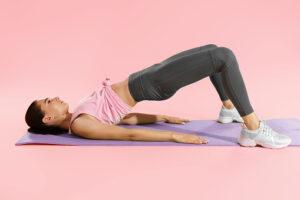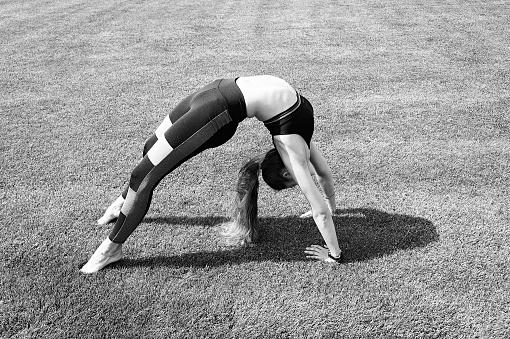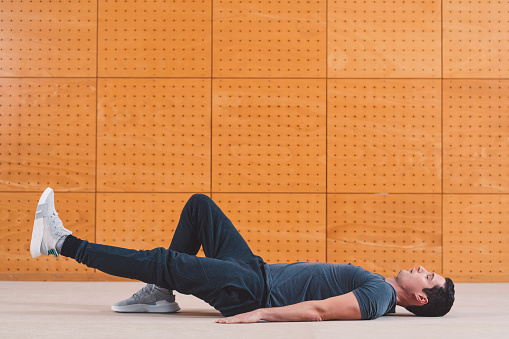The Glute Bridge is a technical term. When performing the Glute Bridge, you’re working on strengthening and toning your glutes. However, it works on your hamstrings and lowers your back as well.
It’s simply, it’s a hip thrust done while lying down instead of standing up. Tempo, bands, and weight can all be increased to make it more difficult. Even if you elevate your feet, it will continue to be a test for you. And no matter how far you’ve come, make sure to let that booty burn. Glute bridge provides numerous advantages. Work on the glutes is essential for developing the posterior chain’s strength, stability, and endurance.
Your gluteus maximus, hamstrings, and hip abductors all play a role in this. You can also achieve stronger glutes by working on this . This exercise also benefits the erector spinae by strengthening them. From your collarbone to your pubis, it extends down your spine.
The rectus abdominis, obliques, and quadriceps work hard as the Glute Bridge antagonist stabilizers to keep it stable. A wide range of motions require glutes, so the more you can strengthen them, the better. Squats, deadlifts, cleans, snatches, and even jumping are among the more powerful lifts . As these muscle groups get more robust, so will your overall power and strength.
The better your score is, the better your posture and the less likely you are to experience lower back pain. Bridge exercises are generally safe if performed with proper form. Risk-free for patients with chronic back problems, and it may even help control discomfort.

Glute bridge is the exercise that you are looking for and it targets your core and butts as well as your legs?
Starting with a simple Glute bridge is a good idea for new players. Overall, more excellent posture is correlated with more giant, stronger glutes. Stabilizing, reducing injury risk, and improving the aesthetics are all benefits.
Glute bridges work which specific muscles in the body?
As a result, your posterior will be strengthened, which will benefit your ability to do more complex actions. This exercise works your glutes (the muscles at the bottom of your legs) while activating your hamstrings and lower back. Leg bridges – how to prevent the most common blunders. Can find this action in a wide range of workout and recovery routines, but many people misapply it.
As a result, avoid the faults listed below and focus on working your glutes effectively. The glute bridge is commonly regarded as a beginner-friendly exercise. However, it is very possible that they aren’t doing it right. Lower back hyperextension. Many folks already have back pain before they begin the workout.
It’s essential to engage our core muscles and maintain a neutral spine whenever we work out. To see if this is true, try lying on your back on the floor in the starting position and see if you can feel any resistance. Squeeze, engage your core, and force your lower back into the floor. Start in this spot and keep your muscles tight throughout the action.
The setup of many folks is a little off. They put more strain on their hamstrings or lower back instead of their glutes. Which is not what the practice is about excessively wide, distant, or close to the body feet.

To impact your Glute Bridge ,you must operate within the confines of your hip and pelvic system. To help your glutes contract more effectively, keep your hips as centered as possible. Make that your feet are correctly situated. Do not overpronate. Your feet should be parallel to your hips.
The rate at which things happen. Consider counting during the Glute Bridge as the most effective method for accomplishing this goal. And should take in both the eccentric and concentric phases at 3-4 seconds each. One of the most common mistakes people make when performing an activity is going too fast.
It is the best thing for your advancement, so slow down. The more time you spend under pressure, the stronger you will become. Using your heels as a propulsion tool. Think of your feet like a tripod to help you with this.
You can isolate the front of your feet in certain permutations, but not all of them. As with any significant compound action, you want to distribute the load evenly across your entire foot. Screw your feet into the ground and thrust up through the entire foot is what you want to do. The act of raising one’s upper body off the ground. Your sternum should feel as though it’s firmly planted on the floor.

An easy error that occurs during Glute Bridge is lifting the entire back and shoulders off the floor and letting your body move freely. Also, make sure you’re lifting from the hips and squeezing your glute to get them going. The higher the bridge, the less work it is; you want to make sure your spine is in a neutral position. Movement and gluteal workload also engage the abs.
The importance of safety and preventative measures:
Before commencing a new fitness plan or adjusting to an existing one, such as Glute Bridge, consult with your doctor. While starting a new workout you can be uncomfortable, executing a bridge should not cause any discomfort. Start with ten repetitions if you’ve never worked out before.
If your lower back or hips hurt, don’t continue. Strive to complete three sets of 25 reps as your strength increases. Two sets of 15 reps can help you train the muscles harder while executing a more difficult modification. Should avoid exercise if you have a health condition or injury, are recovering from sickness or surgery, or any of these circumstances apply to you. Do exercises that target your core, knees, lower back, and glutes until you’ve recovered.



